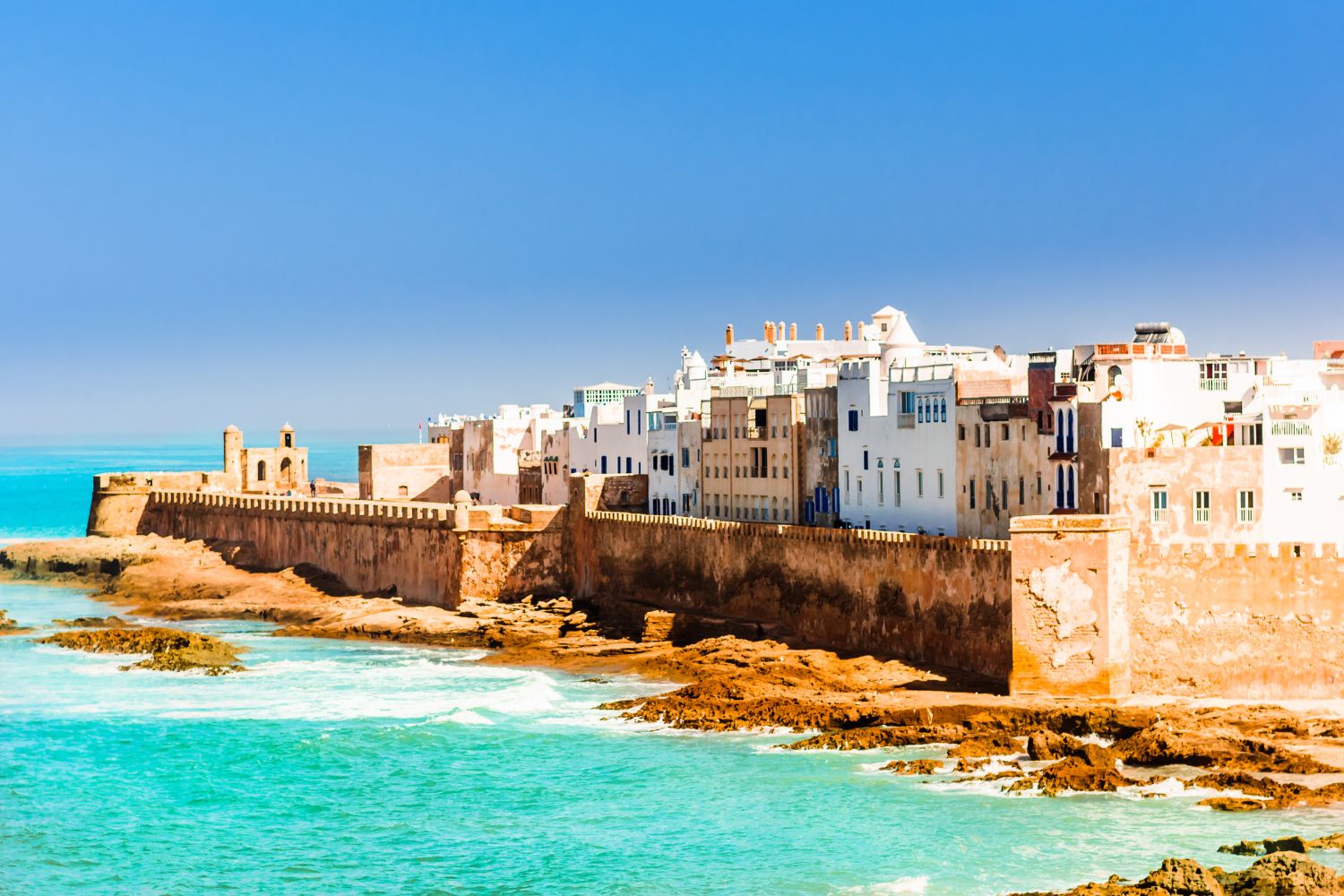Table of Contents
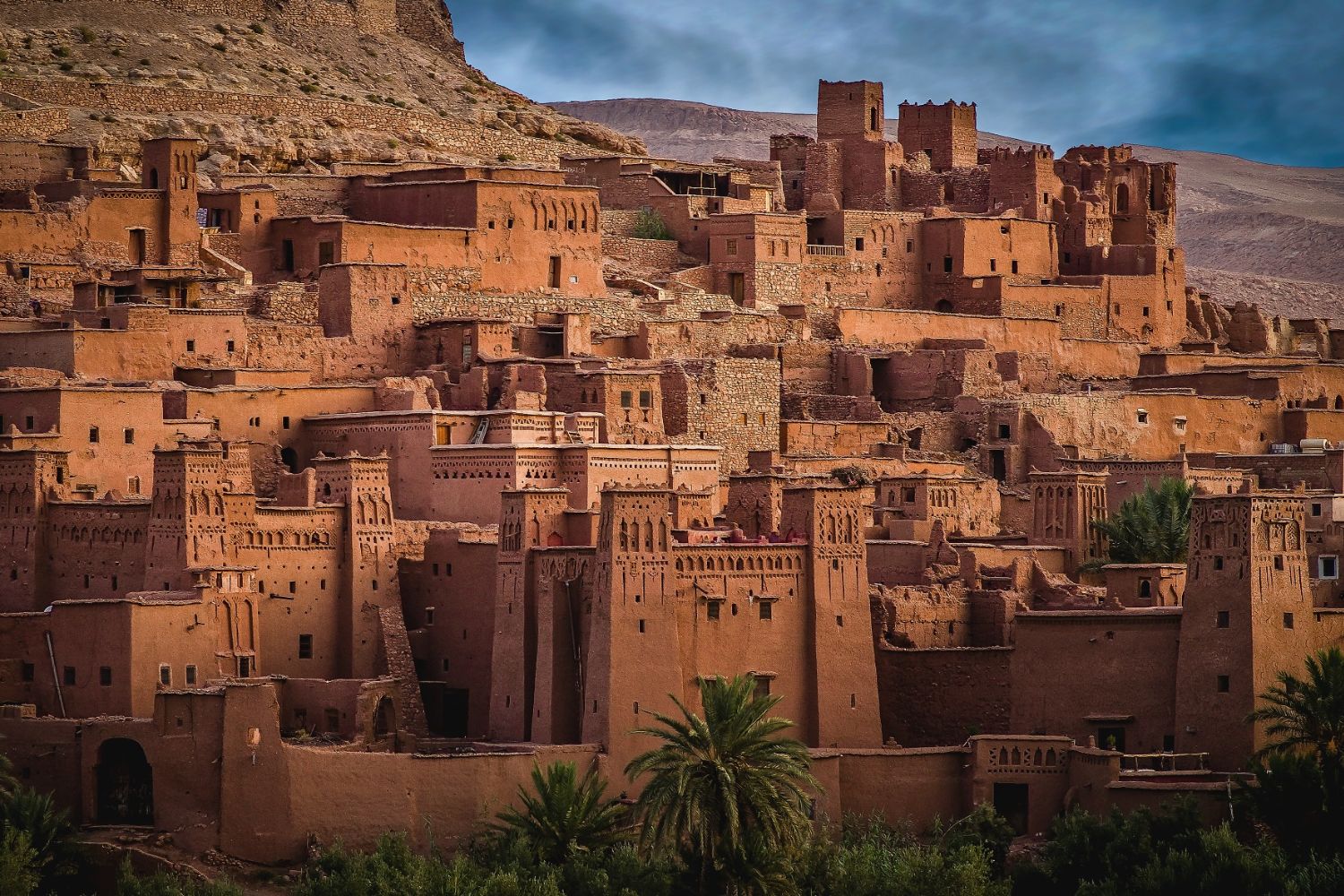
Morocco Historical Sites
Morocco is steeped in history, with a cultural heritage that reflects a blend of Berbers, Arab, African, and European influences. Its rich past is encapsulated in a myriad of historical sites ranging from ancient Roman ruins to stunning Islamic architecture.
Marrakech Historical Sites
- Jemaa el-Fnaa: This famous square lies at the heart of the Marrakech medina (old city). By day, it’s a bustling marketplace where you can find fruit stalls, snake charmers, and local artisans. By night, it transforms into a lively hub of food stalls, dancers, and musicians, capturing the essence of Moroccan culture.
- Koutoubia Mosque: Dominating the Marrakech skyline with its magnificent minaret, the Koutoubia Mosque is a symbol of the city. Built in the 12th century, it is a masterpiece of Almohad architecture and serves as a model for other mosques in Morocco and beyond.
- Bahia Palace: This 19th-century palace is one of the masterpieces of Moroccan architecture, featuring exquisite tile work and ornate gardens. It was built to be the greatest palace of its time, capturing the essence of Islamic and Moroccan style.
- Saadian Tombs: Dating back to the time of the Saadian dynasty in the late 16th century, these tombs were rediscovered in 1917. They are known for their beautiful decoration and the use of Carrara marble. The tombs are a significant reflection of the opulence of the Saadian rulers.
- Ben Youssef Madrasa: Once one of the largest Islamic colleges in North Africa and still one of the most beautiful. The madrasa is an excellent example of Moroccan architecture, with intricate tile work and carvings that showcase Islamic artistry.
- El Badi Palace: Although now mostly in ruins, this 16th-century palace was once a wonder of the Islamic world, known for its grand design and decoration. Today, its remnants give a glimpse into its past splendor and it frequently hosts exhibitions and cultural events.
- Majorelle Garden: Created by French painter Jacques Majorelle and later restored by fashion designer Yves Saint Laurent, this garden is a peaceful escape from the city’s hustle. It features a vibrant landscape of exotic plants and a striking blue villa, now home to the Berber Museum.
- Dar Si Said Museum: This museum, housed in a 19th-century palace, showcases Moroccan art and crafts. It features a collection that includes Berber jewelry, pottery, carpets, and leather goods, offering insights into the local craft traditions.
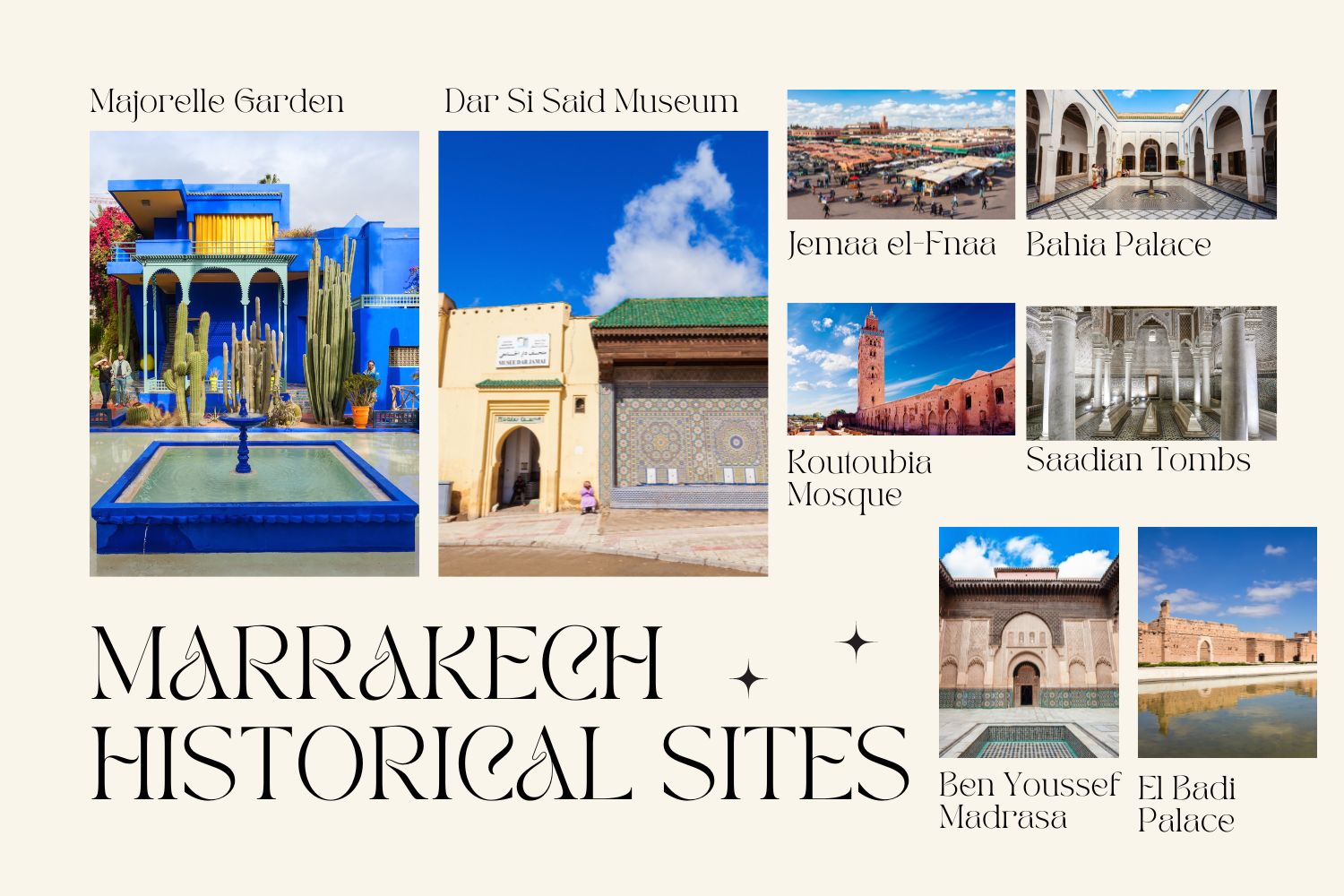
These sites provide a profound insight into Marrakech’s historical and cultural heritage, reflecting both its Moroccan roots and the various influences it has absorbed over the centuries.
Agadir Historical Sites
Agadir, a major city on Morocco’s Atlantic coast, has a distinct character and history compared to other Moroccan cities, primarily due to the earthquake in 1960 that resulted in its modern rebuild. Despite this, there are still several interesting historical and cultural sites in and around Agadir worth visiting:
- Kasbah of Agadir: The Agadir Oufella Kasbah, or fortress, was originally built in the 16th century to protect the city from invasion. Although it was largely destroyed in the 1960 earthquake, the ruins sitting atop a hill offer panoramic views of the city and harbor below. The entrance gate and some walls still stand, inscribed with Arabic script that translates to “God, Country, King.”
- Agadir Memorial Museum: Also known as the Museum of Talborjt, this museum is dedicated to the memory of the 1960 earthquake that devastated the city. It offers insights into the impact of the earthquake and the city’s reconstruction, as well as showcasing Amazigh (Berber) culture and history.
- Amazigh Heritage Museum: This museum focuses on the Berber heritage of the region, displaying traditional artifacts, jewelry, clothing, and musical instruments. It’s a great place to learn about the indigenous culture of the area and the broader region of Souss-Massa.
- La Médina d’Agadir: Built by Italian architect Coco Polizzi, this recreated medina is more recent but crafted using traditional Berber techniques. It includes a complex of craft shops, residences, and an open-air theater, providing visitors with a taste of traditional Moroccan architecture and culture.
- Souk El Had: This is the largest market in the region and one of the biggest in Morocco, containing more than 3,000 small shops. It’s enclosed by walls and has several entries. Here, you can find everything from spices and traditional clothing to local crafts and souvenirs, making it a lively place to experience the local culture and do some shopping.
- Taghazout and Paradise Valley: While not historical sites in the traditional sense, these nearby natural areas offer cultural insights into the lifestyle of the local Berber communities, along with stunning landscapes. Taghazout is renowned for its surfing beaches, and Paradise Valley offers a beautiful escape into nature with opportunities to see traditional Berber villages.
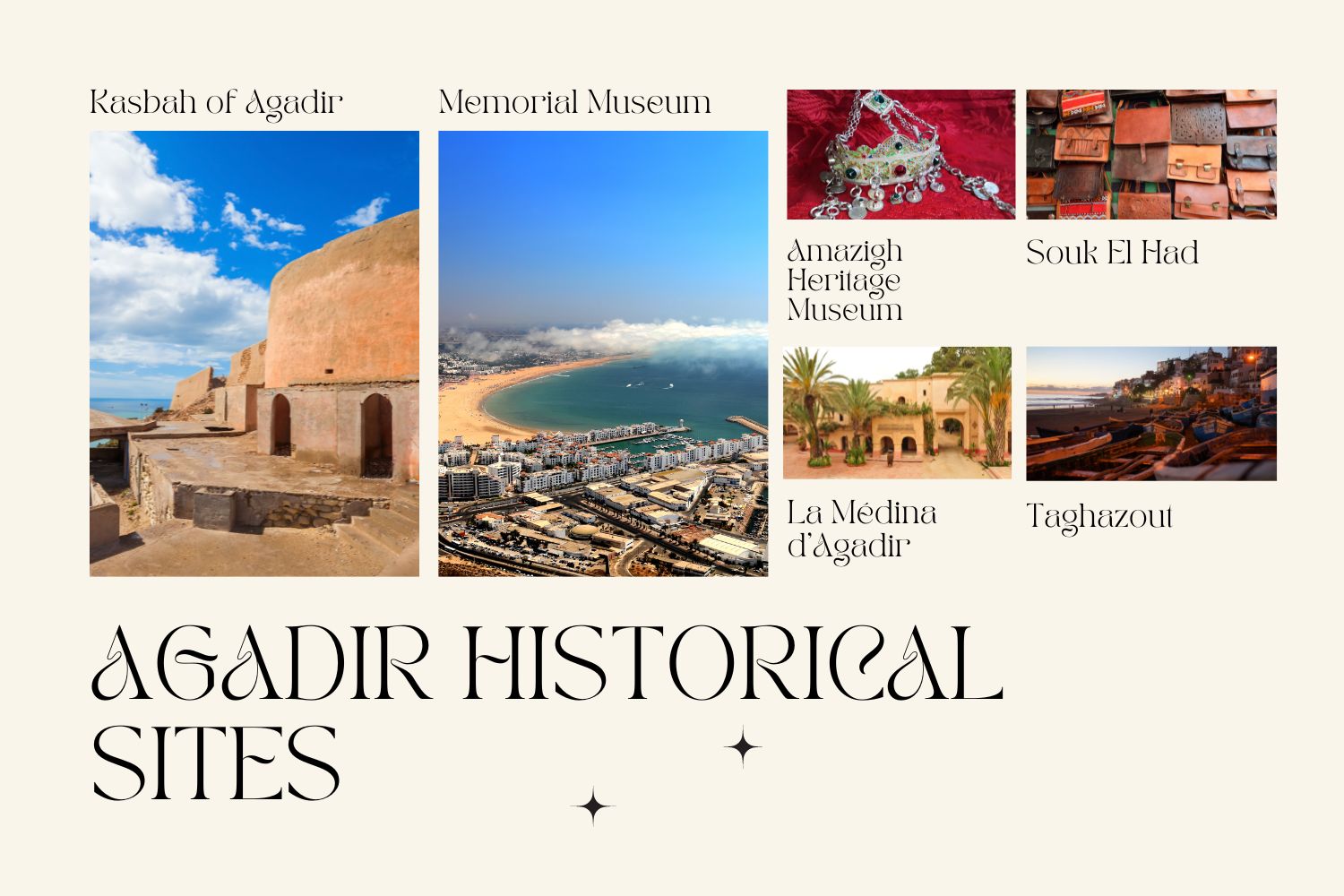
These sites offer a mix of cultural heritage and natural beauty, reflecting the resilience and vibrant culture of Agadir and its surroundings.
Fes Historical Sites
Fes, often considered the cultural and spiritual heart of Morocco, is replete with historical sites that reflect its rich heritage. As one of the best-preserved medieval cities in the Arab-Muslim world, it provides a unique glimpse into the life of an Islamic medieval city. Here are some of the must-visit historical sites in Fes:
- Fes el Bali: This is the old city of Fes, a UNESCO World Heritage site, known for its labyrinthine streets and historic buildings. It is home to the world’s oldest university, the University of Al Quaraouiyine, and is considered one of the largest urban pedestrian zones in the world.
- Medersa Bou Inania: An example of Marinid architecture, the Bou Inania Medersa is both a religious college and a mosque, built in the 14th century. It is one of the few religious places in Morocco that is accessible to non-Muslim tourists. The intricate tile work, carved wood, and detailed stucco are stunning.
- Al Quaraouiyine University: Founded in 859 by Fatima al-Fihri, a woman, this university is recognized by UNESCO and the Guinness World Records as the oldest continuously operating degree-granting university in the world. Its library houses an invaluable collection of medieval manuscripts.
- Dar Batha Museum: A former royal palace, Dar Batha is now a museum of Moroccan arts, showcasing traditional Moroccan crafts including woodcarving, zellij (tile work), and embroidery. The museum also has a beautiful Andalusian garden.
- Chouara Tannery: The largest tannery in the city, dating back to the 11th century, Chouara Tannery offers a unique insight into the traditional methods of leather dyeing that have been used for centuries. The viewing platforms around the tannery provide a vantage point for tourists to observe and photograph the process.
- Bab Boujloud (Blue Gate): The main western entrance to Fes el Bali, this ornate gate is a beautiful example of Moorish architecture with its blue and green ceramic tiles. It’s a popular starting point for tours of the old city.
- Zaouia of Moulay Idriss II: This shrine is dedicated to Moulay Idriss II, who ruled Morocco from 807 to 828 and is credited with founding the city of Fes. It’s a place of pilgrimage for Moroccans, particularly during the festival of Moulay Idriss.
- Nejjarine Museum of Wooden Arts & Crafts: Located in a beautifully restored fondouk (a traditional inn for merchants), this museum displays woodcrafts and other artifacts related to the woodworking craft, along with explaining the history of the fondouk itself.
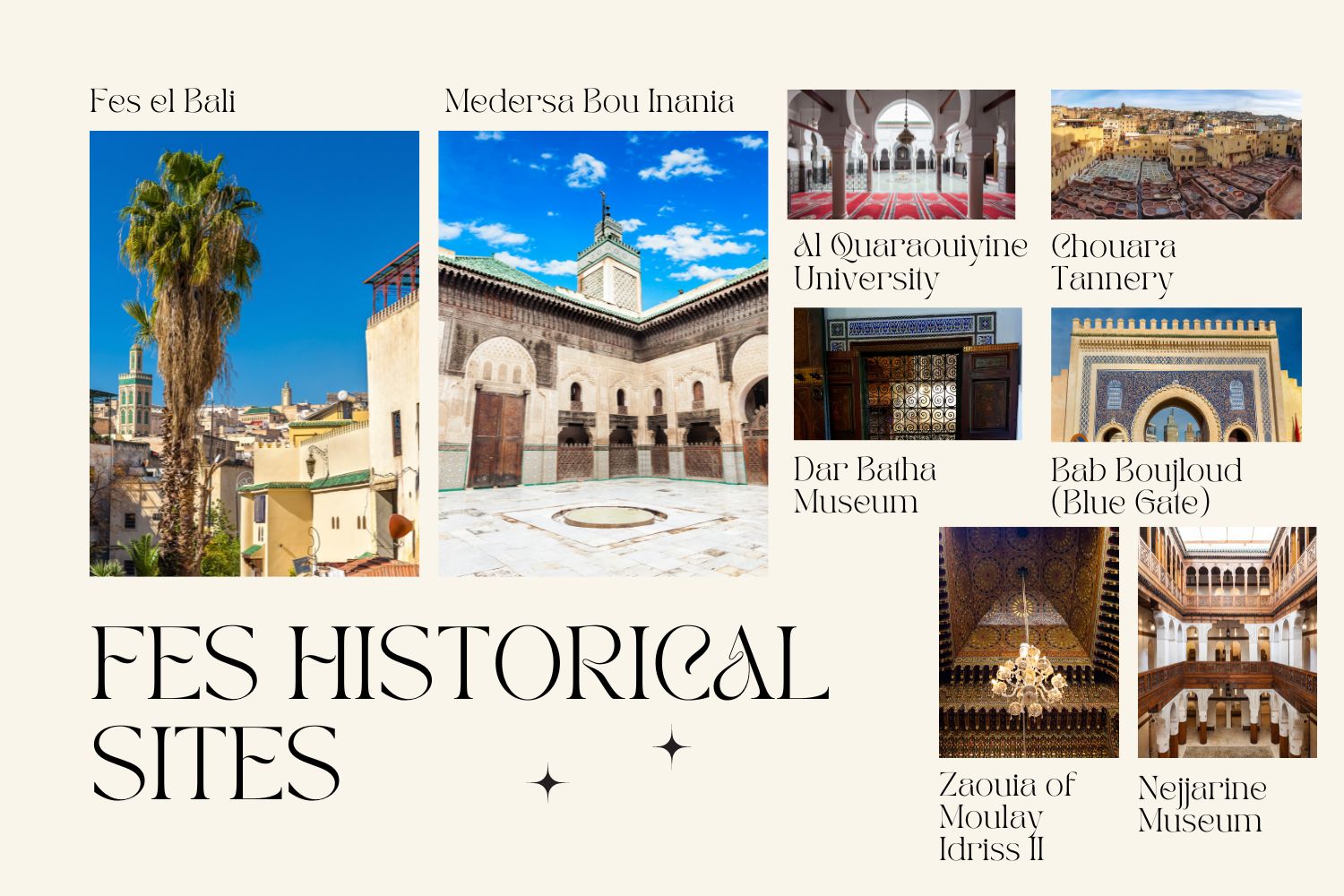
These sites not only underscore the historical importance of Fes but also provide a deep dive into the architectural and cultural traditions that have shaped Moroccan history over the centuries.
Tangier Historical Sites
Tangier, a fascinating city at the crossroads of Africa and Europe, has a rich history influenced by various cultures including Berber, Phoenician, Roman, Arab, Portuguese, Spanish, and French. This blend of influences is reflected in the city’s diverse historical sites. Here are some of the key historical sites in Tangier:
- Kasbah: The Kasbah, located at the highest point of the city, is a historic palace that now houses the Kasbah Museum. This museum displays artifacts from Tangier’s history, ranging from the Phoenician to modern times. The Kasbah itself is a stunning example of Moroccan architectural style and offers panoramic views of the Strait of Gibraltar.
- American Legation Museum: This museum is housed in the only historic landmark of the United States located abroad. It commemorates the historic cultural and diplomatic relations between the United States and Morocco. The building itself is a beautiful example of Moroccan craftsmanship and houses an art collection as well as historical documents.
- Medina of Tangier: The old walled city of Tangier is a labyrinth of narrow alleyways and bustling souks. Walking through the medina, you can explore traditional Moroccan life, shop for local crafts, and even visit the Grand Socco (a vibrant market square) and the Petit Socco, where many famous writers and artists, like Matisse and Bowles, spent their time.
- Cape Spartel: This is not just a beautiful natural site but also a historical one, where the Atlantic meets the Mediterranean. Nearby, you can explore the Caves of Hercules, which are natural caves used by humans since prehistoric times and associated with several myths and legends.
- Tangier Grand Mosque: Originally built on the site of a Roman temple, the mosque was reconstructed by the Portuguese during their occupation of Tangier in the 15th century and later remodeled in the 18th century. It is a significant historical site, reflecting the various cultural influences over the centuries.
- Dar el Makhzen: This former sultan’s palace, located in the Kasbah, is now a museum of Moroccan arts showcasing fine examples of Moroccan art, including textiles, jewelry, and ceramics from various regions of the country.
- St. Andrew’s Church: This Anglican church is a testament to Tangier’s cosmopolitan past. It combines various architectural styles and has a churchyard with graves of several notable historical figures who lived and worked in Tangier.
- The Old Spanish Consulate: This historic building is a fine example of the diplomatic history of Tangier, which was once an international zone. The building itself is notable for its architectural design and the role it played during Tangier’s international period.
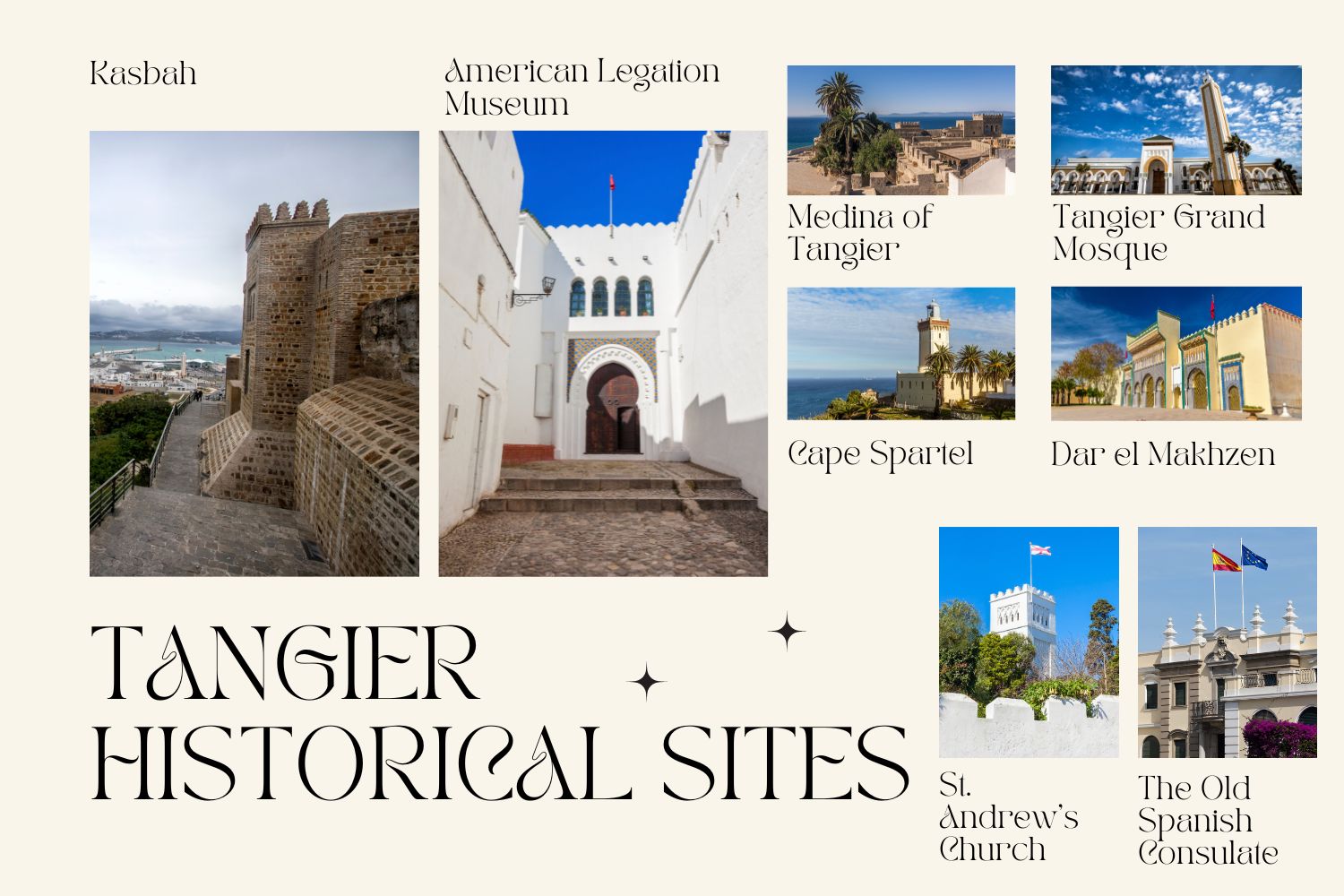
These sites offer a fascinating glimpse into the complex tapestry of cultures and histories that have shaped Tangier over the centuries. Each site tells a part of the story of Tangier’s development as a strategic gateway between continents.
Rabat Historical Sites
Rabat, the capital of Morocco, is rich in history and culture, with a blend of ancient charm and modern governance. This city holds several UNESCO World Heritage Sites and other historical landmarks that reflect its significant role throughout Moroccan history. Here are some of the key historical sites in Rabat:
- Kasbah of the Udayas: This is a fortified residential quarter at the mouth of the Bou Regreg river. Built during the reign of the Almohads, it was originally a military fort before becoming a royal residence. The Kasbah is known for its blue and white walls and offers panoramic views over the Atlantic Ocean. It also houses the Museum of Oudaias, showcasing Moroccan arts.
- Hassan Tower: This unfinished minaret of what was intended to be the world’s largest mosque is one of Rabat’s most famous landmarks. Begun in 1195 under the reign of Sultan Yacoub al-Mansour, the construction halted after his death. The site also includes the remains of over 200 columns that would have supported the mosque.
- Mausoleum of Mohammed V: Located opposite the Hassan Tower, this mausoleum houses the tombs of the Moroccan king Mohammed V and his two sons, King Hassan II and Prince Abdallah. The building is a masterpiece of modern Alaouite dynasty architecture, with its white silhouette and green tiled roof, and is guarded by royal guards.
- Chellah Necropolis: This medieval fortified Muslim necropolis is built on the site of the ancient Roman city of Sala Colonia. It is a peaceful and atmospheric place, combining the ruins of Roman structures with later Islamic constructions, including a mosque and royal tombs. Chellah is particularly beautiful during the spring when it is blooming with flowers.
- Royal Palace of Rabat: This is the official residence of the King of Morocco. While entry to the palace itself is not permitted to the public, visitors can admire the grand architecture and the ceremonial changing of the guard at the palace gates.
- Mohammed VI Museum of Modern and Contemporary Art: Although not a historical site in the traditional sense, this museum is significant as it reflects Morocco’s cultural development and support for the arts. Opened in 2014, it is the first large-scale museum built in Morocco since its independence and hosts both Moroccan and international modern and contemporary art.
- Andalusian Gardens: Constructed during the French colonial period in the 20th century within the Kasbah of the Udayas, these gardens are lush with vegetation, providing a tranquil escape with paths lined with orange trees, jasmine, and other aromatic plants.
- Archaeology Museum of Rabat: This museum houses archaeological finds from various sites across Morocco, including Roman and Islamic artifacts, and offers a good overview of the country’s history from prehistoric times through to the Islamic period.
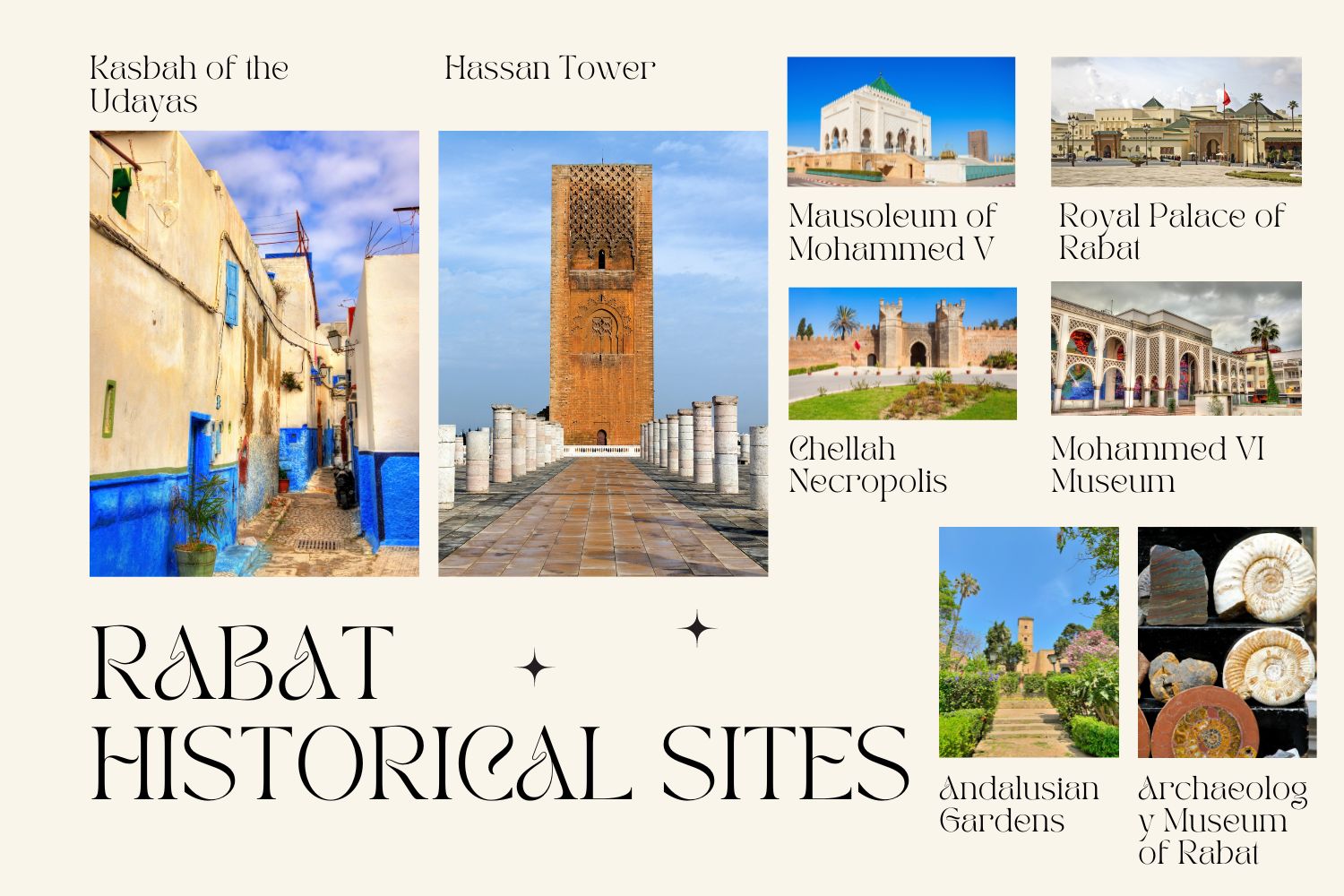
These sites offer a rich tapestry of Rabat’s history, showcasing its development from a Roman outpost to a modern capital city, and highlight the diverse cultural influences that have shaped it.
Casablanca Historical Sites
Casablanca, often seen as the economic heart of Morocco, is also rich with historical and cultural sites that reflect its colonial past and the dynamism of modern Moroccan life. Here are some key historical sites in Casablanca that visitors should consider exploring:
- Hassan II Mosque: This is one of the largest mosques in the world and the largest in Africa, with a minaret standing at 210 meters, making it the tallest religious structure in the world. It was completed in 1993 and is one of the few mosques in Morocco open to non-Muslims through guided tours. The mosque is a masterpiece of Moroccan craftsmanship, utilizing materials and artisans from across the country.
- Old Medina of Casablanca: Unlike the ancient medinas of Fes and Marrakech, Casablanca’s old medina is relatively younger, dating back to the 19th century. It’s surrounded by walls and contains narrow lanes and traditional houses, providing a stark contrast to the modernity seen in the rest of the city.
- Mahkama du Pacha: This is a Hispanic-Moorish building used as a parliamentary building in the Habous quarter, the newer part of the medina built by the French in the 1930s. It houses more than 60 rooms decorated with carved wooden ceilings, stucco, and wrought iron, offering a beautiful example of Moroccan craftsmanship.
- Cathedral Sacre Coeur: This former Roman Catholic church was built in 1930 and is an example of the blending of European and Moroccan architectural styles, featuring Gothic and Art Deco elements. It has since been deconsecrated and is now used for cultural events and exhibitions.
- Villa des Arts: Housed in a beautiful art deco building in the city center, this cultural center is dedicated to contemporary visual arts. It provides insights into the evolving modern art scene in Morocco and hosts various exhibitions from both Moroccan and international artists.
- Royal Palace of Casablanca: Although entry to the palace itself is restricted, the surrounding area and the architecture can be admired from outside. It serves as a royal residence and is an important ceremonial site.
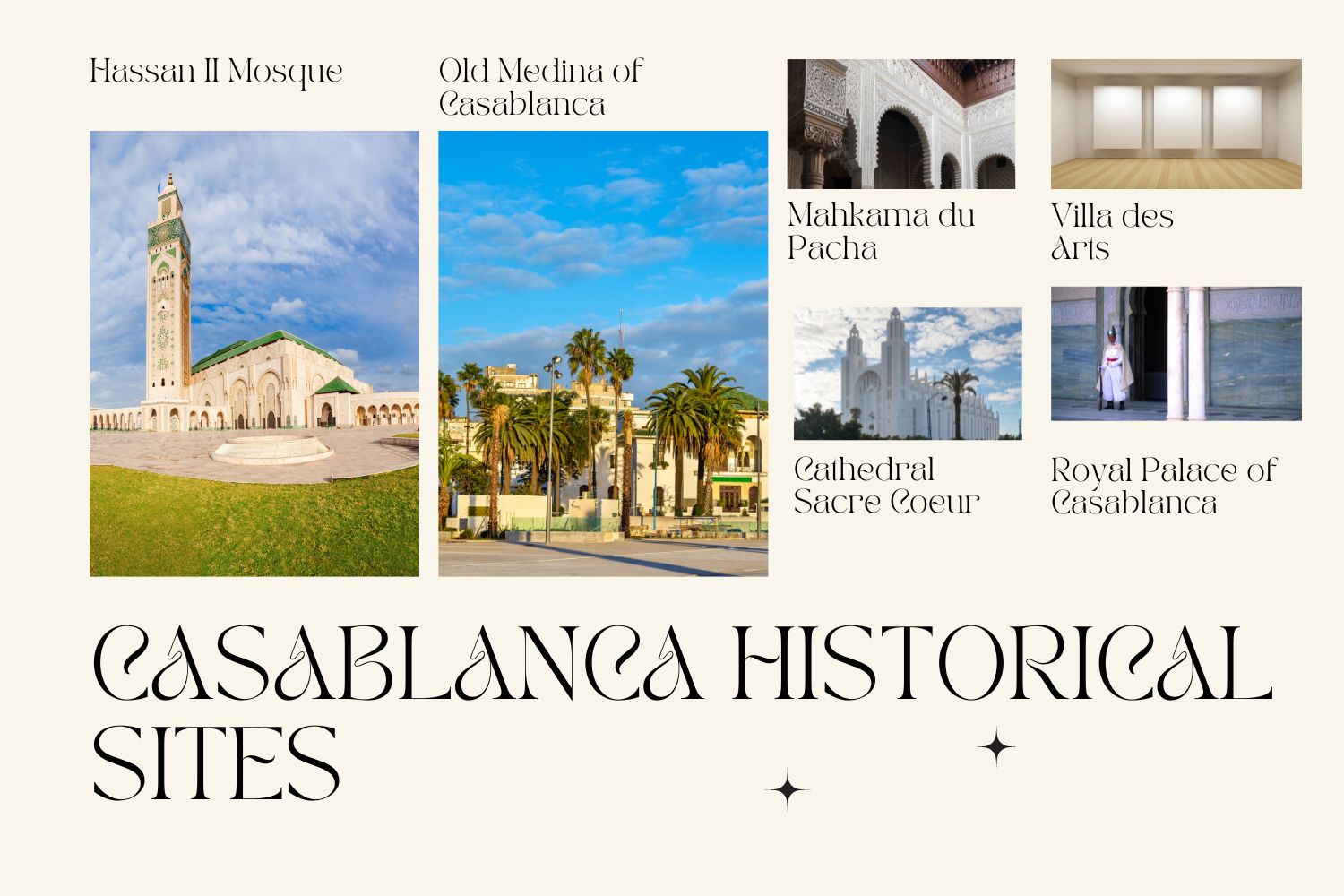
These sites provide a broad perspective on Casablanca’s historical and cultural evolution, showcasing its unique blend of Moroccan tradition and modernity. About us.
